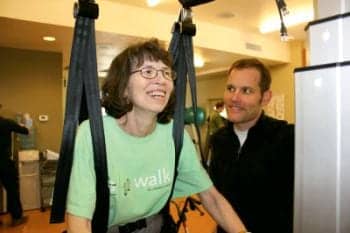A new review shows that ankle and foot splints can help stroke patients regain the ability to walk and keep their balance, although splints—also called orthotics—offer less improvement for other activities, like climbing stairs.
Wrist splints, however, do not lead to signs of improvement in the hands or arms, according to the new review.
“A stroke causes weakness of one side of the body, making it difficult to move the affected arm and leg in everyday activities like walking or eating,” says co-author Sarah Tyson, PhD. “One common way to manage this problem is using a splint to control movement at weak joints, especially the wrist or the ankle. We undertook a Cochrane Review to clarify whether the splints were effective and to make recommendations about how they should be used in practice.”
The reviewers analyzed 14 clinical studies involving 429 participants. The leg splint studies looked for improvement in walking speed, balance, and step/stride length. They also assessed foot drop during the swing phase of walking.
“The results for lower-limb splints show that they can improve walking and balance, at least in the short term,” Tyson says. “This is something of a surprise as, traditionally, physiotherapists have been reluctant to prescribe them, as it was felt orthotics may have a detrimental effect. However, views have been slowly shifting in the last few years as the body of evidence supporting their use has emerged.”
Tyson is a senior research fellow with the Centre for Rehabilitation and Human Performance Research at the University of Salford in Greater Manchester, UK.
The new review appears in the latest issue of The Cochrane Library, a publication of The Cochrane Collaboration, an international organization that evaluates medical research. Systematic reviews like this one draw evidence-based conclusions about medical practice after considering the content and quality of existing medical trials on a topic.
The included studies only examined immediate effects of splints, rather than long-term impact.
Both kinds of splints usually are custom made of plastic or metal. Clinicians mold ankle foot splints to the lower leg and then adjust them to help compensate for the patient’s specific deficit. For the most part, the splints start around the ball of the foot and extend upward to a few inches below the knee.
Arm and hand splints most often include the palm to an inch or so above the wrist. Initially, these braces are used to increase the range of motion in fingers and hands that may have been frozen into a fist or have muscles that are hard to control following a stroke. This is intended to help the patient regain use of their upper extremities to eat, write, or pick things up more efficiently.
However, researchers saw no effect from wrist splints on the ability to use the arm; range of movement at the wrist, fingers, or thumbs; or pain.
“This result was also surprising as the use of orthotics to prevent contractures (loss of range of movement) is thought to be very important in restoring use of the arm after stroke,” Tyson says. “These results throw that belief into doubt; however, the results are based on a very small number of studies, so we need to do larger trials and look at the use of orthotics combined with other established treatments, such as physiotherapy or botulinum toxin [Botox].”
“This review confirms what most rehabilitation professionals had assumed all along, that the lower extremity splints make an immediate, positive impact on a patient’s balance and walking ability,” says Kyle Covington, PT, medical instructor and academic coordinator of clinical education at Duke University School of Medicine. “It is nice to have the evidence to back up what clinical experience was telling us. It also gives more credence to the usefulness of splints, at least in the lower extremities.”
He agreed that the hand and arm results were unexpected.
“That was surprising in that some rehabilitation professionals had assumed that there was a benefit to the patient in splinting the hands and wrists, but as the authors point out, the jury is still out on that question.” Covington says.
Tyson SF, Kent RM. Orthotic devices after stroke and other non-progressive brain lesions. The Cochrane Database of Systematic Reviews 2009, Issue 1.
[Source: Newswise]



